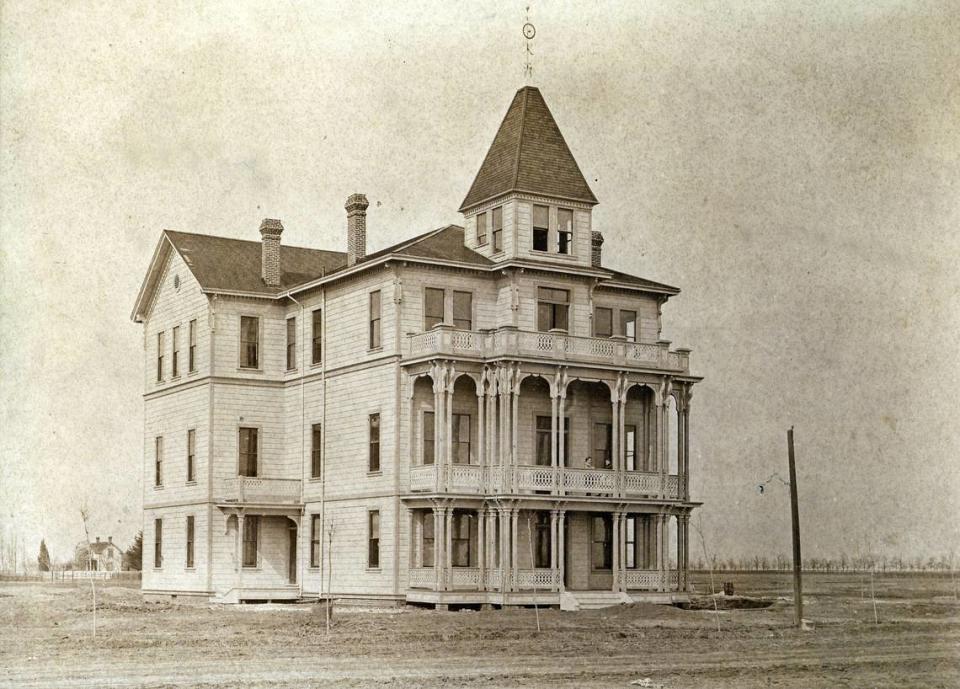The story of Hattie Goldman’s diary, and what it says about Merced life in 1895
Found between the walls in an old Merced house was a very fragile notebook in which paper worms had their share of a “feast” and moisture had smeared the ink.
One may ask if this notebook has some deep, dark secrets because it was “hidden” behind the walls. While the notebook contains diary entries, it is more likely that the book was used as insulation material since it was found among other papers.
The notebook was donated to the Courthouse Museum last spring by a former Merced resident who now lives in Utah. Not much about the notebook was known other than being written in 1895.
After much careful study, I was able to establish ownership of the book. It belonged to Hattie Goldman, the daughter of Merced’s pioneer merchant, Morris Goldman. The Goldman family not only opened the first store in the new town of Merced in 1872 but also left a lasting legacy to Merced with the creation of the Merced Multicultural Arts Center in the 1990s.
Before diving into the contents of the diary, let’s meet the author. Hattie was born in Merced in 1879 to Morris and Amelia “Emily” Goldman of Prussia and Poland, respectively. She was one of six children. In 1895, she became one of the first students at the newly-established Merced High School, the first public high school in Merced County.
In 1905, Hattie married Joseph Frederick Bedesen, whose father co-founded Banks & Bedesen Meat Market. During the early days of her married life, Hattie was not a typical housewife. She helped to run her father’s general store upon his passing in 1915 and supported her husband in organizing Bedesen & McNamara Hardware in 1925. Hattie was not only business savvy but also politically active, being one of the first women to register to vote in Merced County. She lived in Merced her whole life and passed away in 1966 at the age of 86.
Hattie’s notebook records her activities in September and October of 1895 and provides some insight into what Hattie was like and what was going on in Merced then.
Hattie loved riding horses and bicycles, going for a hike, attending balls, or just hanging out with her friends. While most of the entries reveal her positive outlook on life, some offer a glimpse of her tender sentiments and strong moral convictions. When she found out her brother accidentally caused a range fire at the family sheep camp during a hunting trip, she was angry with him for not owning up to it but felt sorry for him because he had a terrible fright.
Being a young lady of 16, Hattie was naturally curious about and fascinated by the changes in her community. Her inaugural diary entry, written on September 9, pays tribute to California’s Admission Day event in Sacramento, where Merced Concert Band took part in the celebration. She then wrote about Sam Shaw’s Comedy Troupe coming to town, the Valley Railroad (Santa Fe) being built in Merced, and the Young Men’s Institute succeeding beyond expectations.
Although the telephone came to Merced years earlier, it did not really expand until Hattie’s time. She writes, “Sept. 16th, 1895. At last our little burg has a telephone system; it is a very convenient thing to have, and one finds a great deal of pleasure talking through it. The poles are all over Merced and it makes this town look more city feel (sic).”
Progress was definitely on Hattie’s mind as was school and her upcoming exams.
The main reason that she kept a diary was that it was required for her Composition class, taught by Principal Jefferson Elmore. During this time, Merced High School had examinations every six weeks. Hattie’s Composition book would be checked and graded by the end of every six weeks. Hattie wrote about getting ready for the upcoming exams on October 3; then, on October 21, she expressed her anxiety about waiting for her grades. What took her mind off her exams just a bit, in her next day’s entry, was the preparation for the Native Daughters Ball on Thanksgiving eve.
When Merced High School was organized, it was temporarily housed in the Old Academy Building on Canal Street, about three blocks north of Hattie’s house. In the October 2 entry, she writes, “At last Merced is to have a High School. The plan is already made out and it will be relocated in the south square of the Court House Park.” The high school was completed in 1897.
Hattie’s diary may have been one of the earliest historical records of Merced County high schools. By 1897, Merced was no longer the only high school in the County with the establishment of Westside Union High School in Los Banos. Then, there was Dos Palos High School in 1907, Le Grand in 1909, Hilmar in 1911, Gustine in 1913, Livingston in 1924, Atwater in 1958, El Capitan in Merced in 1959, Los Banos in 1965, and Golden Valley in Merced in 1994.
The first 100 years of Merced County high school history are featured in the 2023 Merced County Historical Society Calendar, which can be purchased at our annual membership meeting on February 5.
This free event will be held at the Merced County Board of Supervisors’ Chamber at 2 p.m. Our keynote speakers, Charlie Galatro and Dan Nelson, will talk about the life of Cattle King Henry Miller. At this meeting, Jacquelyn Benoit of Livingston, Julie Marchini of Chowchilla, Geri Freer of Merced, and Atwater Historical Society will be awarded for their efforts in preserving and disseminating Merced County history.
Sarah Lim is director of the Merced County Courthouse Museum.


